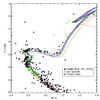| Issue |
A&A
Volume 561, January 2014
|
|
|---|---|---|
| Article Number | L9 | |
| Number of page(s) | 7 | |
| Section | Letters | |
| DOI | https://doi.org/10.1051/0004-6361/201322584 | |
| Published online | 15 January 2014 | |
Online material
Appendix A: CMD and membership probabilities
In this section we summarize the results presented in Pasquini et al. (2012), focusing in particular on the three stars discussed in the Letter.
YBP1194, YBP1514, and S364 belong to the M 67 sample that includes a total of 88 stars. All targets have V mag between 9 and 15, and a mass range between 0.9–1.4 M⊙.
We selected main-sequence stars (included YBP1194 and YBP1514) with a membership probability higher than 60% and a proper motion shorter than 6 mas/yr with respect to the average according to Yadav et al. (2008). For the giants we refer to Sanders (1977). The RV membership was established for the latter following the work of Mermilliod & Mayor (2007), who studied the membership and binarity of 123 red giants in six old OCs, and of Mathieu et al. (1986), who made a very complete RV survey of the evolved stars of M 67 with a precision of a few hundreds of m s-1. The majority of the other stars were selected according to Pasquini et al. (2008), who used several VLT-FLAMES exposures for each star to classify suspected binaries. We found that YBP1194, YBP1514, and S364 are probable RV members with a mean RV within one-sigma from the average cluster RV. For the latter, we adopted the value of ⟨ RVM 67 ⟩ = 33.724 km s-1 and the dispersion of σ = ± 0.646 km s-1 estimated in Pasquini et al. (2012).
Table 3 shows proper motions and membership probability for the three stars discussed. Details about selection criteria and motion errors can be found in the original Yadav et al. (2008) and Sanders (1977) works.
In Fig. A.1, we report the observed region of the color-magnitude diagram (CMD), indicating in different colors the the position of the stars considered in this letter and the solar analog, as determined in Pasquini et al. (2008). The three stars analyzed in this work lie quite well on the cluster sequence in the CMD. We superimposed the isochrones from Pietrinferni et al. (2004) with solar metallicity and age corresponding to 3.5 Gyr (black curve), 4.0 Gyr (dark-blue curve) and 4.5 Gyr (light-blue curve). We also included the 4.0 Gyr isochrone (red curve) with a slightly lower reddening (E(B − V) = 0.02 instead of 0.041, Taylor 2007). This curve seems to match the colors of the turnoff better (see also the discussion in Pasquini et al. 2012). In the same figure, we report the Padova isochrone using E(B − V) = 0.041 ± 0.004, with solar metallicity, age 4.47 Gyr, and Y = 0.26 (Girardi et al. 2000).
Given that the values of stellar parameters have influence on the estimation of the planet masses, we evaluated the effects on the host star masses and radii of using isochrones with different ages and slightly lower reddening. While for the two
main-sequence stars YBP1194 and YBP1514 we found no significant incidence, for the giant S364, an age uncertainty of ±0.5 Gyr and a lower reddening would induce an error on the star mass of 4% and on its radii of 3%. Therefore, we decided to include this effect in the uncertainties of S364 listed in Table 1 and in the error of the planet mass.
 |
Fig. A.1
CMD of M 67 (photometry from Yadav et al. 2008) for probable members (Pμ > 60%). The isochrones are taken from the BaSTI library (Pietrinferni et al. 2004). The isochrones in black, dark blue, and light blue correspond to 3.5 Gyr, 4.0 Gyr, and 4.5 Gyr with a reddening E(B − V) = 0.041 ± 0.004 (Taylor 2007). The isochrone in red is a 4.0 Gyr with a lower reddening (E(B − V) = 0.02). The isochrone in orange is a 4.47 Gyr from Girardi et al. (2000) with E(B − V) = 0.041 ± 0.004. The location of the Sun, if it were within M 67, is marked with a ⊙ in yellow. |
| Open with DEXTER | |
Object ID, proper motions, and membership probability of the targets; reference.
Relative RV measurements, RV uncertainties, bisector span, and ratio of the Hα core with respect to the continuum (see Pasquini & Pallavicini 1991) for YBP1194.
Relative RV measurements, RV uncertainties, bisector span, and ratio of the Hα core with respect to the continuum (see Pasquini & Pallavicini 1991) for YBP1514.
Relative RV measurements, RV uncertainties, bisector span, and ratio of the Hα core with respect to the continuum (see Pasquini & Pallavicini 1991) for S364.
© ESO, 2014
Current usage metrics show cumulative count of Article Views (full-text article views including HTML views, PDF and ePub downloads, according to the available data) and Abstracts Views on Vision4Press platform.
Data correspond to usage on the plateform after 2015. The current usage metrics is available 48-96 hours after online publication and is updated daily on week days.
Initial download of the metrics may take a while.


